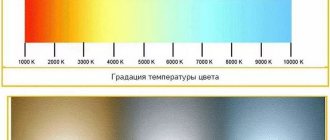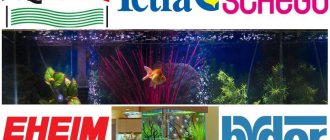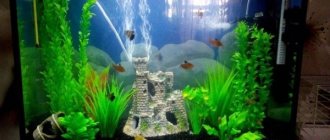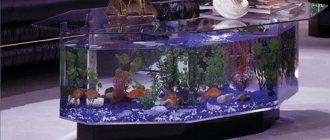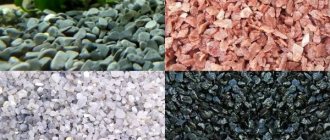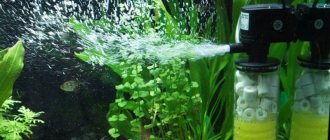How many hours a day should a filter-compressor work in an aquarium?
and I bought myself a time relay and set the program - hour of work - hour of rest during the day. At night he works for an hour and a half and rests for half an hour. I monitored the oxygen content in the aquarium for a day and was able to choose this mode. Look, if the fish are just starting (Watch carefully! DO NOT allow oxygen starvation!) to move closer to the surface (but not to eat or for some other obvious reason) - then turn on the aeration. It is IMPOSSIBLE to keep the compressor on all the time! This is constant vibration, and it is very harmful! The compressor can be turned on around the clock only in one case - if the filter is external, that is, vibration is not transmitted to the aquarium. It is recommended to install a check valve even before a conventional sprayer to reduce noise. This heater with a thermostat must be turned on constantly, but the compressor must be turned on only when needed! Ideally, you shouldn’t have any equipment AT ALL in your aquarium! It is better not to overpopulate the aquarium and choose the right ratio of plants and fish, as well as respect the length of daylight hours.
How to check that the indicator is normal?
It is easy to find out that aeration is normal. The fish behave normally and do not cause alarming suspicion. If aeration is disrupted, they change behavior - they often swim up and swallow water. The situation becomes critical when the fish swallow the void. We urgently need to take action.
- Too much aeration will not bring any benefit, but rather will harm the inhabitants of the aquarium. An excess of oxygen causes gas embolism in fish - air bubbles appear in their blood and the fish dies. To prevent this from happening, do not install too many compressors, they will cause a supersaturation of oxygen in the water.
- If aeration is too weak . The normal oxygen concentration is 5 mg/l or slightly more. If aeration is below this indicator, then many fish will simply suffocate and plants will die. No benefit can be found in this.
Why turn it off?
Turning off the compressor at night can have various reasons - the owner wants to save energy or does not consider it necessary to operate it at night, believing that the fish are sleeping.
However, you must understand that any pets come with various expenses, so even before purchasing animals, you need to think about whether you are ready for additional expenses for living creatures. Fish need their own aquarium, additional lighting and aeration, food and plants that make their daytime existence easier.
Night aeration
As you know, during the daytime, under the influence of light, plants produce oxygen. And at night, with a lack of lighting, plants not only stop releasing oxygen, but, on the contrary, actively consume it. In addition, if there are a lot of plants and living creatures in the container, there is a chance that by the morning you can find dead fish. Therefore, there is no need to turn off the aquarium aerator at night, even though the compressors create a lot of noise. There are several ways to solve this problem:
- You can place the compressor in a sound-absorbing box made of polystyrene foam.
- Move the device to the next room, where it will not interfere - for example, to a balcony or to a closet.
- Install foam shock absorbers.
In general, you can cope with noise without any problems. In addition, you can connect the compressor through a step-down transformer. Just keep in mind that aeration performance will decrease significantly.
Silent compressors for aquariums
In fact, silent compressors for aquariums (diaphragm, valve) do not exist. Any compressors for an aquarium, whether they are foreign or domestic, make noise. True, there is no need to compare them with analogues of the first releases such as AEN.
To rid yourself of the annoying noise of the compressor, you need to foresee in advance the place where the aquarium will stand. It is not advisable to place the compressor in the bedroom. If during the day the noise of the compressor may not be noticed, then at night, when all the noise intensifies, the noise of even the quietest compressor, roughly speaking, will get you.
Otherwise, in order to get rid of the noise of the compressor in the bedroom, you will have to move the aquarium to another room, which is very labor-intensive. You can turn off the compressor at night, but this is not recommended when the heater is on or the aquarium is overcrowded.
Do catfish clean the aquarium?
Surely, sellers in pet stores and friends who own aquarium catfish often told you that these fish clean the aquarium, so you don’t have to do anything extra. This is not entirely true. Catfish actually clean the aquarium, picking up leftover food, food waste or some kind of scales from the bottom. But, if the area of the aquarium is large enough, and there are very few fish, catfish simply will not cope with their task.
This way the fish will be cleaned up as best they can, but you will still have to do the basic cleaning to keep them from dying. It is necessary to purchase a water purification filter to help aquarium residents.
Exploitation
This device belongs to the category of bought and for a long time. But in order for the device to serve for a long time, it is necessary to properly monitor it:
- Cooling. Only a correctly installed device will not overheat. If the temperature is higher than the permitted norm, it should be taken to a workshop or repaired yourself;
- Read the operating instructions for the aerator. It is recommended to disconnect the device from the power supply at night. This is to ensure that the device has the opportunity to “rest”. And this has a positive effect on its service life.
- There are models that it is not recommended to turn off often, but rather leave them on and they always work. The moment of rest for such aerators is the time when cleaning and changing the water in the vessel is performed. If the device is turned off, you need to keep an eye on the aquatic inhabitants.
- Regardless of the model, the devices should be cleaned. Because it will begin to poorly saturate the water with oxygen.
And in conclusion, is a compressor needed in an aquarium? Yes, it is. But the choice of a compressor for an aquarium, what model, and what parameters to pay attention to when purchasing are determined based on the volume of the vessel, the number of inhabitants and the presence of algae, and on the financial capabilities of the aquarist. But the main thing is to remember the saying “he who is stingy pays double!”
Tricks and secrets of aquarium aeration
- Increasing the water temperature in an aquarium increases the oxygen consumption of its inhabitants and vice versa. Knowing this, you can quickly help the fish in case of asphyxia.
- Hydrogen peroxide. Few people know about its use in the aquarium. She can:
- revive suffocated fish;
- fight unwanted living creatures (hydra, planaria);
- help treat fish (bacterial infections, parasites, protozoa);
- fight algae on plants and aquariums.
But you need to know how to use it correctly, otherwise you can only cause harm and poison all the fish. In this article we will not dwell on this. If anyone is interested in this issue, information can be found on the Internet.
- Oxidants. They come in different purposes: for long-term transportation of fish, for small and large aquariums, for ponds. The essence of the work: hydrogen peroxide and a catalyst are placed in a certain vessel. As a result of their reaction with each other, oxygen is released.
In conclusion, I will say that you should not underestimate the importance of aeration in an aquarium. Moreover, there is a large selection of equipment for it. You can find inexpensive and high-quality models.
When choosing a device, you need to compare its power, the volume of the aquarium, the number of inhabitants and their CO2 needs. Manufacturers usually indicate the recommended volume for each model.
And remember that only an aquarium that provides healthy conditions for its inhabitants can be beautiful.
Principle of operation
The principle of operation of the compressor A special tube is placed in the vessel, at the end of which there is a sprayer.
Through it, the compressor supplies air which enters the atomizer. It is the sprayer that saturates the water with small bubbles. In addition to aeration, mixing of water takes place, as well as water in a vessel at the same temperature. Sometimes the aerator is used for decorative purposes. Water bubbles look beautiful, complemented by colored lighting. Such a multi-colored aquarium will look gorgeous.
The aerator may not work all day. It is enough to turn it on at night, when there is no light and the algae do not produce oxygen by absorbing carbon dioxide.
In summer, it is advisable to turn on the aerator more often, so as to simultaneously enrich the water with oxygen and mix it.
During the spawning period, it is recommended to turn on the device. There is no time limit on how long the device should work. Only the aquarist, observing the aquatic world, should regulate its operating time.
What it is?
Aeration refers to the movement of water volume, due to which it is enriched with oxygen.
During this process, air currents pass through the water column, splitting into small gas bubbles . They are the suppliers of O2.
In nature, aeration occurs naturally - due to wind, underwater springs, and currents. This is not possible in a limited space. Here the main suppliers of O2 are plants and aeration equipment.
Power
This characteristic determines the performance and the maximum amount of energy consumed. In addition, the immersion depth of the device depends on the power. The deeper you plan to place it, the higher this characteristic should be. Widespread models are with power from 2 to 11 W. The following compressor models are considered the best in this category.
Schego Optimal
Price:
- 1500-2100 rubles.
Characteristics:
- productivity – 250 l/hour;
- power – 5 W;
- weight – 600 g;
- cord – 1 m;
- Air flow adjustment – yes.
Main advantages:
- air filters can be replaced;
- almost silent;
- The design is designed to work in a suspended state.
Minuses:
- No.
Eheim air pump 400
Price:
- 2500-3100 rubles.
Characteristics:
- productivity – 400 (2 x 200) l/hour;
- number of channels – 2;
- power – 4 W;
- weight – 846 g;
- hose – 2 m;
- Air flow adjustment – each channel has it.
Main advantages:
- channels can work separately or as one using a tee;
- has rubber feet that dampen vibration;
- possibility of hanging.
Minuses:
- sprayers can only be fixed with a suction cup on glass walls;
- the hose is short.
Flaws
The main disadvantage of compressors is noise. Many tank owners install their aquarium pump in soundproof boxes. This partially helps solve the problem. Some manufacturers make models that are installed directly into the container. During the daytime, their work is almost inaudible.
When installing the aeration device, you must be careful, since the bulk is powered by electricity. Failure to comply with safety measures can lead to a short circuit, which will lead to the death of the inhabitants of the tank.
Alternative
The noise during operation of the aerator causes inconvenience. There is an alternative replacement - an oxidizer. This is a homemade filter aerator for an aquarium. With its help, oxygen is supplied to the reservoir through a chemical reaction. It is based on the decomposition of hydrogen peroxide into oxygen. A catalyst is required for continuous operation. Its role is played by metals. As a result of the reaction, the catalyst is oxidized and releases oxygen into the water. The device is used without electricity. Does not make noise during operation.
How does a lack of oxygen in water manifest itself?
But all of the fish listed above, which can exist without additional oxygen enrichment, may feel unwell from its lack. Therefore, if the following symptoms are present in aquarium pets, immediate action must be taken:
- passivity, lethargy;
- protruding gills;
- rapid breathing;
- swallowing air on the surface of the water;
- dull color;
- reduced immunity;
- slow growth, which becomes noticeable after some time.
If such symptoms occur, you should immediately install a compressor with an air stone, at least temporarily. If such a unit does not solve the problem, then you need to install stationary equipment - a compressor and a filter.
Piston
The operating principle of this type of compressor is based on the movement of a piston that pushes out air. Rotational movements of the shaft are converted into oscillatory ones. This leads to achieving the required air supply power. If your fish live in a bedroom or recreation room, then a piston compressor for an aquarium would be ideal. It doesn't make as much noise, but it's not as cheap as a membrane one. You can use both types of compressors at once. Turn on the piston at night, and the membrane during the day. The latter consumes less energy.
The main advantages of a piston compressor:
- durable;
- almost silent;
- high performance;
- Suitable for large aquariums.
Main disadvantages:
- consumes a lot of electricity;
- expensive.
How does it work?
The principle of operation of a compressor in an aquarium is clear even to those who do not understand instruments. The device captures air from the environment and delivers oxygen inside the tank using tubes or hoses, the ends of which are lowered deep into the tank. At the ends of the hoses there are nozzles, thanks to which the air comes out in the form of tiny bubbles.
Tiny oxygen bubbles, in turn, rushing to the surface, mix the liquid in the tank, preventing the water from stagnating. And in combination with additional color lighting, the flow of bubbles not only benefits little residents, but also looks fantastically beautiful. In addition to standard compressors for aquariums, models have been developed that include a filter - pump. They can be external or internal, but the second type is more popular. The point is cost - by purchasing a submersible compressor, you can save a lot of money.
Water and temperature requirements
The temperature in the aquarium affects not only the fish's environment, but also their biological and chemical processes. Therefore, it must be the same in all layers of water so that the creatures are not harmed.
For catfish, the optimal temperature is from 18° to 28°C. But, since this is an unpretentious fish, sometimes they can withstand small deviations from this norm. Water hardness for catfish is in the range of 8-12. The water must not be salty or seawater, otherwise the fish will die.
To maintain the temperature of the aquarium you should use:
- Special aquarium refrigerator.
- Air conditioning in the room.
- Ice or cold accumulator.
Types of regulation
The aquarium compressor is divided into two types according to the adjustment method:
- Adjustable.
- Unregulated.
In adjustable models, the structure of the device includes a regulator, by rotating which the owner can change the power and the supply of oxygen bubbles to the tank. In turn, adjustable models are divided into the following types:
- A device with an electronic type of regulation works by limiting the stroke of the membranes, but has a drawback: when turned on for a long time, the device gets very hot.
- The essence of the mechanical type of work is that the oscillations of the membranes are limited by magnets or claws.
- Shutting off the valve - if you close the outlet valve located on the hose, you can control the supply of oxygen to the artificial reservoir.
In addition to adjustable ones, there are devices with no regulation - devices that are not equipped with additional elements to control the air supply. In other words, it is impossible to change the flow intensity, as well as the noise emitted by the device. In addition, such models consume a lot of electricity, so some aquarists build silent aquarium compressors with their own hands, using a cooler and special taps.
Let's look at the varieties
Eheim 100/200/400 - compressors for aquariums, refers to external devices. Suitable for both fresh and sea water. The compact size allows it to be installed to supply air anywhere. The switch allows you to adjust the power level of the oxygen flow. Plus - minimal noise.
Schego Optimal is a model that is in demand among professional aquarists. Its popularity is explained by the fact that it can be connected in parallel to several aquariums.
PRIME - this model belongs to mini devices. Small, compact model. Despite its small size, it is a powerful compressor for an aquarium, as it works in a vessel up to 100 cm high. The processor is easy to connect.
BubbleMaker is a submersible type of device. It creates a vortex of bubbles and is an aerator that is immersed in water; the main thing is to bring the power wire out. This model belongs to internal devices, as it is mounted inside. There are external differences compared to previous models. The convenience of using a compressor in an aquarium is another plus.
Professionals often modernize some models, so to speak, they make an aquarium compressor with their own hands, for example, adding a mini fountain. The BubbleMaker model can also be improved; the aeration pipe can be adjusted - reducing or increasing the noise level. As a result, the bubbles will be either larger or smaller, resulting in bubbly dust. CO2 can also be supplied through the same tube.
AQUAEL Versamax 1 is a device that attaches to the sides of the aquarium. The noise is like the sound of water. In demand among Russian consumers.
Types of compressors
According to the main classification, compressors are divided into piston and membrane. The differences lie in the cost of the devices and the level of noise they emit.
Piston
The operating principle of this device is based on the movement of the piston. It pushes out air and directs it into the depths of the water. The device has a higher price than a membrane one, but produces less noise.
Piston compressors are ideal for bedrooms and recreation rooms. Their advantages are durability and high performance. These types of compressors are recommended for installation in large-volume aquariums.
The main disadvantages of piston compressors:
- high price;
- high power consumption.
Recently, piezo compressors have competed with piston aerators in terms of noise emission. But they have a significant drawback - they are low-power and are not suitable for installation in aquariums with a volume of 200 liters or more.
Membrane
The movement of air in such devices occurs from a chamber connected to the membrane, in which pressure differences are observed. They occur due to vibrations of the magnet, which are also transmitted to the rubber membrane. The advantage of this type of compressor is its low energy consumption.
Flaws:
- low power;
- noisiness.
What fish can live without oxygen supply?
To be more precise, every creature living on planet Earth needs oxygen to maintain the vital functions of the body. Fish breathe using gills, capturing water, which, passing through the respiratory organs, is freed from oxygen. After this, it enters the blood. Therefore, clean, oxygen-rich water is important for aquarium inhabitants. But not for everyone. Some fish get it not from water, but from the atmosphere. They capture a certain amount of oxygen from the air, and organs adapted for this are responsible for gas exchange in the body. So, what fish are so unusual:
- fish with intestinal respiration with bags for swallowing atmospheric air on the back, through which the necessary oxygen enters the blood - catfish, loaches, representatives of marine fauna;
- species with a labyrinthine structure of the respiratory organs - cockerels, gourami, guppies, lalius;
- individuals that breathe with a swim bladder, which is intended for gas exchange, are representatives of the polypteran family.
Aquarium catfish, eels and aquarium loaches do not require aeration. But a filter is needed.
Contrary to popular misconception, barbs and goldfish are extremely demanding of oxygenated water.
Gourami
One of the brightest representatives of aquatic fauna that does not absorb oxygen from water is gourami. They belong to the order Perciformes, and the respiratory organ has a labyrinthine structure, thanks to which oxygen penetrates the body. These aquarium fish definitely need access to atmospheric air. In nature, gourami are often found in bodies of water with low oxygen content - swamps, sewers, and “stagnant” reservoirs.
Bright representatives of aquatic fauna that do not absorb oxygen
We take into account the details
The following factors must be taken into account:
- dimensions and shape of your aquarium;
- population of fish and snails;
- presence of algae in the aquarium;
- decorating elements.
The numerical characteristics of the water surface depend on the dimensions of your aquarium. The larger the space, the better the exchange of gases between living organisms and the external environment. In this case, the fish have excellent conditions for life, and the compressor also additionally regulates the oxygen supply.
Thus, it is always recommended to have, if not a huge, then a much larger aquarium
than is required for the number of free-swimming fish. The larger the tank's capacity, the less likely it is that your pets will experience oxygen deprivation at night if you plan to turn off the oxygen supply compressor. Try to avoid crowding in the aquarium by any means - remove growing plants, purchase a larger aquarium.
And if there is an overpopulation of fish, then remove them from the existing composition, leaving only the normalized number of individuals.
Based on everything described above, we can conclude that additional aeration can only be turned off in a spacious aquarium with a small population of algae and living creatures.
The next morning you can always determine for sure whether you made a mistake by turning off the compressor. If it is obvious that the fish have a lack of oxygen, do not allow the aeration to be turned off.
Remember about plants that consume oxygen at night - if there are a lot of them, they will “take” oxygen from the fish at night, complicating their breathing process.
If you take into account all the above factors and do not miss important points that lead to the death of fish, then the additional air supply can be turned off at night. In other cases, the compressor must
work constantly
.
You will learn whether it is possible to turn off the compressor in an aquarium at night from the following video.
Aquarium compressor
Every experienced aquarist knows how important it is to have a high-quality aquarium compressor that fits the tank size. It enriches the water column with oxygen, prevents water masses from stagnating, which avoids turbidity and the development of various diseases and putrefactive processes that can adversely affect the inhabitants of the aquarium.
Types of aquarium filter-compressors
The operating principle of aquarium air compressors is quite simple. Using a special device, air is mechanically forced into the outlet hole, to which a special hose is attached. This hose is lowered as low as possible into the aquarium and the water is saturated with oxygen. Most often, a special sprayer is also attached to the end of the hose, which splits the air stream into many tiny bubbles, which allows the aeration process to be carried out much faster. Aeration is the supply of air into a water mass, which is why aquarium compressors are often also called aerators.
Depending on the air injection mechanism, there are two main types of aquarium compressors: membrane and piston. In membrane systems, the supply of oxygen into the air occurs due to the movement of special membranes. This is a great option for a silent aquarium compressor, so it can be kept on all the time, even at night. Such an air pump will not interfere with the rest of the people in the room. But such devices also have their drawbacks. So, such a quiet aquarium compressor does not have enough power to aerate very large water containers or column aquariums. However, for home aquariums it is usually quite sufficient (the largest volume of water in which a membrane compressor can operate is 150 liters).
The second type of aquarium compressor works based on the movement of a piston, which forcefully pushes a stream of water into the hose. With this mechanism, you can even create very powerful aquarium compressors that can handle large volumes of water. Most often they are used in aquariums located in public places and large in size. Column aquariums are also most often equipped with a similar compressor. The disadvantage of this mechanism is the increased noise level compared to the membrane version.
Installation and use of the compressor
Most often, the air compressor should be located above the water level. Therefore, its external unit can be placed on a shelf next to the aquarium or directly on its lid. There are also options with vacuum suction cups, which are easily attached to the walls of the aquarium from the inside or outside. Depending on the design features, the aerator can operate from an electrical outlet or from batteries. After installation, the pump tube is lowered as low as possible into the aquarium; it is advisable to place it at the bottom (some owners, guided by aesthetic considerations, bury the sprayers in the ground, although this is not recommended).
If we talk about the operating mode of the aerator, then in the case of silent mechanisms, most aquarium owners leave them running constantly, since this device does not consume a large amount of energy. Meanwhile, some owners believe that it is more useful to periodically turn on the aquarium compressor (the optimal mode is considered to be two hours of operation and two hours of rest). In addition, it is recommended to constantly turn on the aerator after feeding the fish, as well as at night. In this case, the aquarium will be better enriched with oxygen, and putrefactive processes caused by fish waste products and food debris will slow down.
>
How to choose and 3 best
When choosing a compressor for your aquarium, there are some factors to consider. Not every campaign produces quality products. With a constant supply of oxygen to the tank, aquarium compressors must have good power. When choosing a device, you need to pay attention to its performance and characteristics.
Among the well-known brands of aerators are the following:
Compressors from Schego, which produces devices for any type of aquarium. Depending on the volume of the tank, you can purchase a device with different power. We produce portable Schego optimal aerators that run on alkaline batteries. They are convenient when moving or lacking access to electricity. The devices are equipped with special legs that ensure stability. If necessary, they can be hung on the wall. The devices of this manufacturer have a number of positive aspects:
The Ukrainian company Collar produces good compressors that are distinguished by their reliability. Designed for a small aquarium with a volume of up to one hundred liters. It can be installed at a depth of up to 1 meter. The use of a high-precision air chamber made it possible to achieve a low noise level during operation of the device. Quite powerful for a compact size.
An air compressor from Aquael is one of the most common devices. It occupies leading positions in compressor ratings. Devices of various capacities are produced, which allows you to choose a model for aquariums of any size. Suitable for freshwater and marine tanks. If necessary, you can replace the prefilter. Equipped with two air channels.
It has the following positive qualities:
- Compact size.
- Low noise level during operation.
- Availability of a valve for power regulation.
- There is an LED indicator to monitor operation.
- Low power consumption.
The choice of an aerator must be approached with care. Some models cannot equip the tank with the required level of oxygen because they do not have the required power. The noise level and dimensions of some models are not suitable for some aquarists. By studying the positive aspects and characteristics of various devices, you select the best aquarium compressor that is suitable for your tank.
Advice from experienced owners
To avoid unforeseen situations, experienced fish holders recommend the following to beginners in the field of aquarium keeping:
- Replace compressor components, taking into account natural wear and tear.
- With prolonged use, the device becomes more quickly contaminated, as a result of which the holes become clogged and oxygen is supplied in insufficient quantities. You can eliminate the problem by thoroughly cleaning the device.
- The aerator hoses or tubes are periodically checked for leaks.
- In order not to risk the well-being of the fish, experienced water enthusiasts recommend keeping a spare mini-aerator in case of breakdown.
An aquarium compressor is a convenient device designed to preserve and protect the life of fish and shellfish at home. Thanks to the use of an aerator, aquarists can admire colorful fish and lush green plants in their own pond every day.


